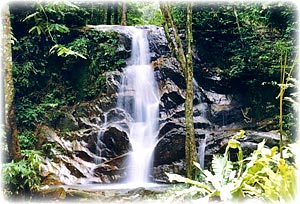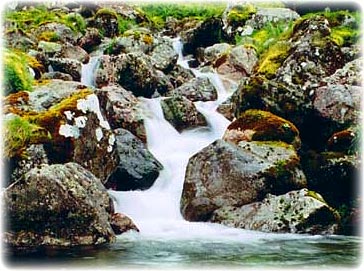Beginners Photography - Capturing Moving Water
This site is dedicated to helping everyone to take better photos, so what makes this section different?Well, the information here is written with the beginner in mind.
For example, you'll find many 'tooltips' among these pages, giving you, the reader extra information about specific photographic terminology.
The tooltips are underlined with a dotted line. Simply hover your mouse over the word(s) to get some extra information.
Capturing Moving Water in Photography
By Amy Renfrey

Beginners Photography - Photorealistic Images:
If you permit the automatic settings in your camera to record the moving water, chances are it will opt to utilize a fast shutter speed to eliminate blur.While this gives an accurate depiction of the moving water, it may not create the tone or texture that is desired.
Beginners Photography - Smooth Water:
By adjusting camera settings manually the appearance of moving water can be made smooth and almost "soft". This is done by choosing a slow shutter speed.This may require reliance on a tripod to prevent hand shake and blurriness, but the result will be dramatically different than from an automatic settings. The slower the speed of the shutter the blurrier the passing water becomes giving it the softer and opaque appearance.
Beginners Photography - Basic Shutter Speeds :
For blurry water it is best to begin with one eighth second setting and work down from there, but true smooth water usually is not available until a shutter is open for a full second or more. Also the lower the ISO on the shot the more likely the image captured is going to be satisfactory.This is where the smallest aperture and highest f/stop will result in the slowest possible shutter speed for the ISO and lighting conditions.
Beginners Photography - Remember Distance:
The distance between the camera and the image of water it is capturing changes the effect of shutter speed on the "blur" factor. The closer the camera is to the water the more quickly the blur is captured.Low lighting may exist within many moving water environments and this too will necessitate slower shutter speeds and even tripods.
Beginners Photography - Rely on Shutter Priority settings:
experiment with a few shutter speed settings for moving water, and allow the shutter priority to determine the f-stop and aperture on the image.Record which results you find the most appealing and visit other bodies of moving water to further experiment.
Beginners Photography - Don't Limit Subjects:
remember that water flows to the sea shore in large waves and gentle lapping tides, it flows from lawn sprinklers and regularly spurts and erupts from public fountains, so experiment at many types of locations.Moving
bodies of water never present the
same image capture requirement which is why photographing moving water
can be
such a fun and highly experimental venture.
Many photographers return
to the
same locations throughout the year to record the variations in plant
life,
water levels and to learn about photographing in the changing light and
seasons.

|
This page was written by my good friend Amy Renfrey. For a steady supply of Amy's tips, have a look at her professionally tailored ebooks and ezines, written especially for beginner photographers. |
More beginners photography articles!
- Beginners Photography - The Basics
- Capturing Moving Water
- Shooting the Night Sky
- Editing Images in Photoshop
- Low Light and Indoor Photography
- How digital cameras work - understanding light and sensors
- Getting More Light on Indoor Photographs
- Learning digital photography

